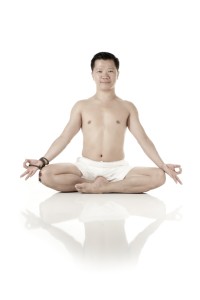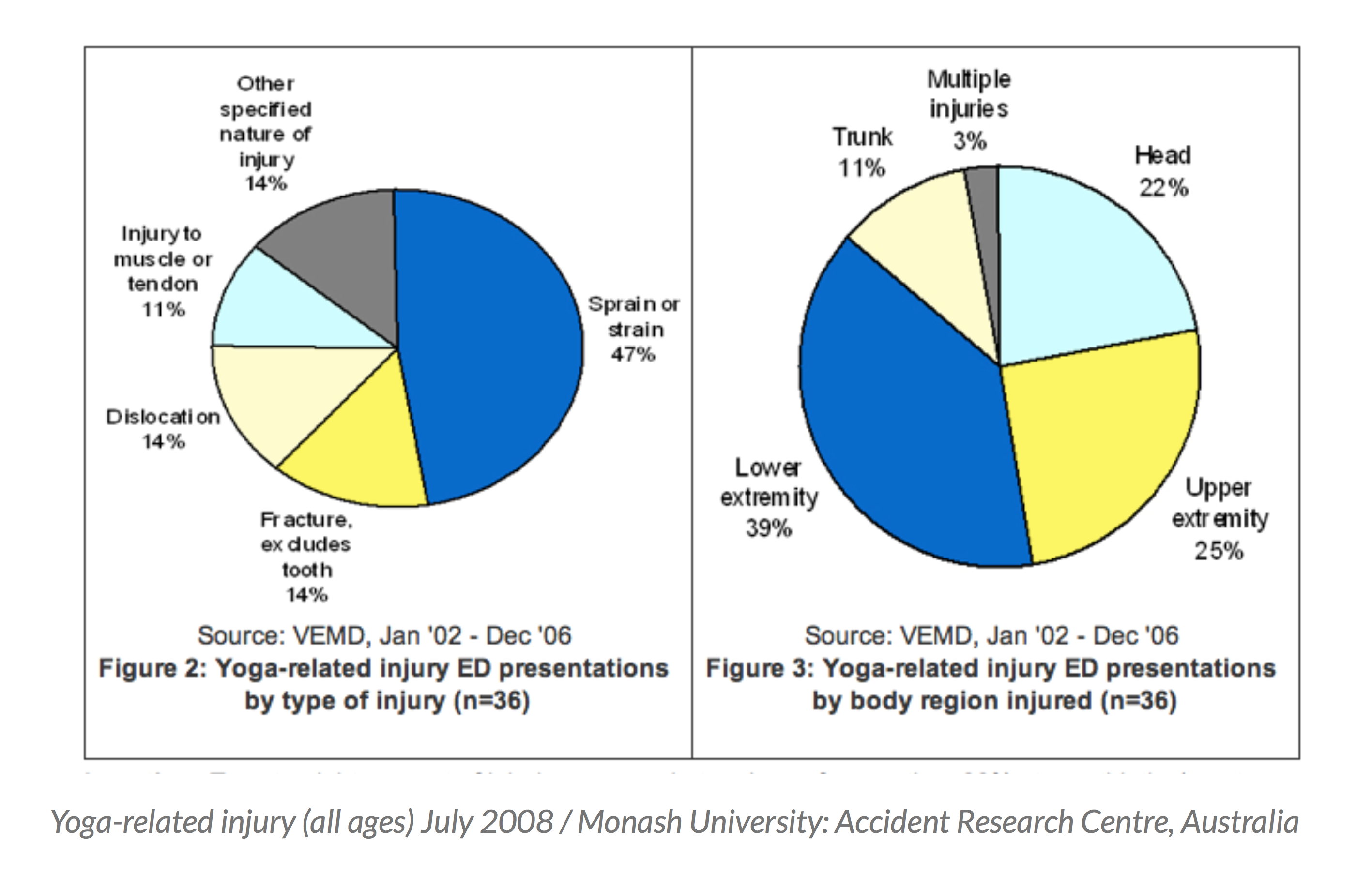Click here for: Wellness Program l Yoga l Research & Studies
“Some people claim to have had breakdowns after attending such programs as Landmark Forum [see Lell, who had one after attending (Lululemon 2 days seminars for staffers) Landmark sessions, and Abstracts of Articles in Psychological Journals concerning est and The Forum]. According to Robert Howe, Stephanie Ney, 45, claims that a two-day Landmark Forum seminar “stripped her of her natural psychological defenses and unleashed the specter of a failed relationship with her father,” leading to a nervous breakdown and commitment to a psychiatric clinic.” 12 Utterly Bizarre Facts About The Rise Of Lululemon, The Cult-Like Yoga Brand / businessinsider.com
update: How Yoga Can Wreck Your Body from the New York Time Magazine

Yoga injuries have become one of the top injuries in North America, as the 5000-year-old practice becomes more popular. Due to the demand, Yoga studios and gyms don’t want to be left out of the trend, which mean competition in the business world. They scramble to hire instructors with lack of experience or aerobics instructors who’ve maybe attended a weekend yoga workshop. Studios and gyms, pack the classes like canned sardines. I have been to classes where my yoga mat is only 2 inches apart from the others in all four directions and the teachers play hard rock music. I was fearful in balancing poses, not because my strength to hold the pose but my inability to control my neighbor possibly falling on me while I’m in my pose. As a result, after the class I was more tense and had more nervous energy than before I started the class.
Most yoga students think that this gentle 5000 year old art can’t hurt them. Students have somehow lost their critical thinking and stop questioning what the teachers say or even actions such as harsh adjustments. The students view the teacher as guru. Couple this with the North American mentality of “doing more is better” and injuries from overzealousness are the result.
Yoga has a great potential to heal at a deep level, thus it also has potential to hurt you at a deeper level. One of my private clients recently learned this fact. Four hours or so after he took a gym yoga class, his back began to spasm. It was painful and uncomfortable for days, and potentially undid the 4-6 months work we did together in our private yoga therapy.
Yoga poses are designed to unlock your body’s tension, and to assist you to have a better life. By freeing your body’s tension it leaves your mind open to have more clarity. It is not what yoga poses you can do, but how you are using yoga poses to help you. This can change from hour to hour or day to day…

Just like wearing clothes, you have different moods and that’s what makes you more authentic to yourself. It is you, who wears the clothes according to how you feel. You do not let the clothes wear you, like a hanger. This is no different in yoga. You do yoga to make you feel better not because you want other people looking at you while you are in a pose. But if you like others to look at you and tell you how good you look in the wheel or shoulder stand pose consider this: gravity is a bitch! It varies form person to person, certain parts of your body, including your face, will not fall as gracefully as you may think. In the wise words of Blanche Devereaux (The Golden Girls), “my bosom look bigger and the face wrinkles smooth out when I lie flat on my back.”
True words Blanche. We call that a Corpse Pose. It is one of the hardest poses to master in yoga. We look good in them because the pose requires us to completely surrender to ourselves with self acceptance and to be in the present. Ms. Devereaux may have referred to the end of a sexual escapee session, but how true it is that yoga can also achieve that blissful state. Most of you reading this will think, “I never got that good vibration from practicing yoga.” I didn’t say it was easy. Like everything in life, practice, practice yogis’. Yoga, just like sex, gives you great joy and peace but don’t make it into an addiction and forget the reason / objective of why you are doing yoga.
To improve your physical, mental and spiritual self. Go into the pose, master the pose with your strength (not flexibility), then let go and surrender in the objective area. Control without controlling, don’t micro management, you may lose the big picture.

Adam Quang: Author of Secret Journal of a Yogi: Chair Yoga, a registered yoga instructor with the Yoga Alliance E-RYT 500 Master level certification and has been teaching yoga since 1994. Adam works as a yoga therapist, specializing in building back muscles and improving flexibility.
Adam has worked with everyday people, Hollywood celebrities, and members of Royal families. Over the past thirty years, he has been sharing and practicing the art of meditation, yoga, tai chi, and yogalate and manages his youthful look due to these practices.
————-
“Richard Faulds, a senior Kripalu Yoga teacher in Greenville, Virginia, echoes Modestini. “When you’re striving and the mind has an agenda to get somewhere, the body may resist and injury may occur,” explains Faulds. However on the contrary, he notes, “True yoga starts with radical self-acceptance. You are fully present with what is, observing the self without judgment. When the body knows that the mind is kind, it will open and release.”…..
“Some people have such faith in yoga that it overcomes their critical thinking,” Kaminoff says. “They think yoga practice—or a yoga teacher—can’t hurt them, which isn’t true.” Yoga injuries range from torn cartilage in the knees to joint problems from overly aggressive adjustments to sprained necks caused from “the domino effect” of being knocked over by classmates while doing Sirsasana (Headstand). “Many classes now are so crowded that a single person out of control can take out any number of people,” notes Kaminoff, who treated a client with a neck sprain that occurred when a neighbor fell out of an inversion and knocked her into another yogi. And teaching carries its own hazards, he explains, recalling a teacher who was kicked in the face by a student she was helping, resulting in a chipped tooth, bruised face, and bloody nose.”….
Harsh adjustments can be especially risky for flexible people who can easily be pushed deeply into a pose without knowing that an injury may result. To counter this, Kaminoff advises knowing your own areas of strength and weakness and studying consistently with a teacher you know and trust…..
The most common posture to cause injuries—especially in people over 40-is Shoulderstand, according to Larry Payne, Ph.D., a Los Angeles yoga teacher and therapist and coauthor of Yoga Rx (Broadway Books, 2002) “Shoulderstand bends the neck the opposite way. Practiced too aggressively, it might contribute to problems ranging from bone spurs to disk injury. Some of its big lessons are to act with awareness, balance, nonaggression, and common sense. If people do that, they will enjoy a safe and happy practice.” Roger Cole….
—
Common injuries
Injuries to the knees are among the most common in yoga. “With the knee, you must watch poses that incorporate extreme bending or rotation, especially when those movements are combined,” says Jardine. “The knee is basically two bones sitting on top of each other; it’s good for mobility, but not for strength or stability.” Poses that incorporate the half or full lotus cross-legged position, or those such as the revolved side angle pose, where the knee is bent and rotated and taking some of the body’s weight, are particularly hard on knees.In addition to the knee, injuries to the back and wrists are also common in yoga. Poses that fully extend the back, such as the full upward bow, can cause disc problems, while wrists are vulnerable in weight-bearing postures such as the downward dog (hands and feet on the ground with legs straight and bum in the air) and plank (pushup position with straight arms and legs). One major warning sign is losing the feeling in any part of your body. “If you start getting pins and needles in any part of your body, you’re blocking circulation from tight muscles or there is tension in a nerve,” says Jardine. “That’s a red flag. You should come out of the pose carefully, give your muscles a break, then try the pose again.” If pins and needles persist after the pose, consult a health-care specialist.
